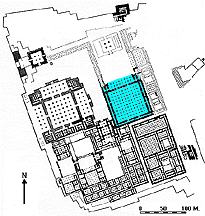The Throne Hall

Next to the Apadana, the second largest building of the Persepolis Terrace is the Throne Hall (also called the “Hundred-Column Hall”), which was started by Xerxes and completed by his son Artaxerxes I (end of the fifth century B.C.). Its eight stone doorways are decorated on the south and north with reliefs of throne scenes and on the east and west with scenes depicting the king in combat with monsters. In addition, the northern portico of the building is flanked by two colossal stone bulls. In the beginning of Xerxes’ reign the Throne Hall was used mainly for receptions for representatives of all the subject nations of the empire. Later, when the Treasury proved to be too small, the Throne Hall also served as a storehouse and, above all, as a place to display more adequately objects, both tribute and booty, from the royal treasury. Concerning this, Schmidt wrote of the striking parallel in a modern example of a combined throne hall and palace museum where the Shah of Iran stores and exhibits the royal treasures in rooms and galleries adjoining his throne hall in the Gulistan Palace at Teheran.
- Throne Hall, Portico and N Part of the Apadana, with the Palace of Darius in the Background, P 58323
- Throne Hall, Portico and N Part, with Darius’ Palace and the Apadana in the Background, P 637
- Throne Hall, General View with the Apadana and the Gate of Xerxes, P 633
- Throne Hall, Debris in the Portico, N Doorways and Windows of the Main Hall, P 312
- Throne Hall, Audience Scene and Guards of E Doorway, N Wall, W Jamb, P 316
- Throne Hall, Audience Scene on E Doorway in N Wall, W Jamb, P 315a
- Throne Hall, Audience Scene and Guards from the E Doorway in the N Hall, W Jamb, P 315b
- Throne Hall, Audience Scene and Guards on the E Doorway in the N Hall, W Jamb, P 315c
- Throne Hall, Audience Scene and Guards on the E Doorway in the N Hall, W Jamb, P 315d
- Throne Hall, Audience Scene and Guards on W Doorway of the N Wall, W Jamb, P 319b
- Throne Hall, Audience Scene and Guards on W Doorway in the N Wall, E Jamb, P 318
- Throne Hall, Audience Scene on E Doorway in N Wall, E Jamb, P 313a and b
- Throne Hall, S Doorways, SW-S View, P 320
- Throne Hall, W Doorway in S Wall, W Jamb and Neighboring Niches, P 324
- Throne Hall, E Doorway in S Wall, W Jamb, P 321
- Throne Hall, Throne Bearers on W Jamb, E Doorway in S Wall, P 323a and b
- Throne Hall, E Doorway in S Wall, E Jamb, P 123
- Throne Hall, Enthroned King and Attendant on E Jamb, W Doorway in S Wall, P 24976
- Throne Hall, Hero’s Combat with a Horned Lion-Headed Monster on S Jamb of N Doorway in E Wall, P 330
- Throne Hall, Hero’s Combat with a Bird-Headed Monster on S Jamb of N Doorway in W Wall, P 328
- Throne Hall, Obverse View of the Foundation Record, P 24735; See P 24736 for Reverse View
- Throne Hall, Reverse View of the Foundation Record, P 24736; See P 24735 for Obverse View
- Throne Hall, Portico, W Side, Showing Bull Fragments, P 58184
- Throne Hall, Portico, Workmen Hoisting a Stone Slab, P 58178
- Throne Hall, Portico, E Side, P 57292
- Throne Hall, Column Base in the Portico, P 1186
- Throne Hall, Column Base from the Portico, P 29359
- Throne Hall, W Guardian Bull of the Portico, P 827
- Throne Hall, Unfinished Gate, Remnants of S Doorway and Guardian Bulls, P 60707
- Throne Hall, Addorsed Bull Capital from an Unfinished Gate, P 23335
- Throne Hall, Left Half of an Addorsed Bull Capital from an Unfinished Gate, P 57495
- Throne Hall, Restored Bull Capital, Addorsed Bull from an Unfinished Gate, P 57496
- Stone Stairs to Tunnel System East of the Throne Hall, P 25038

